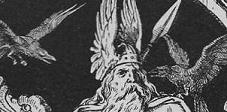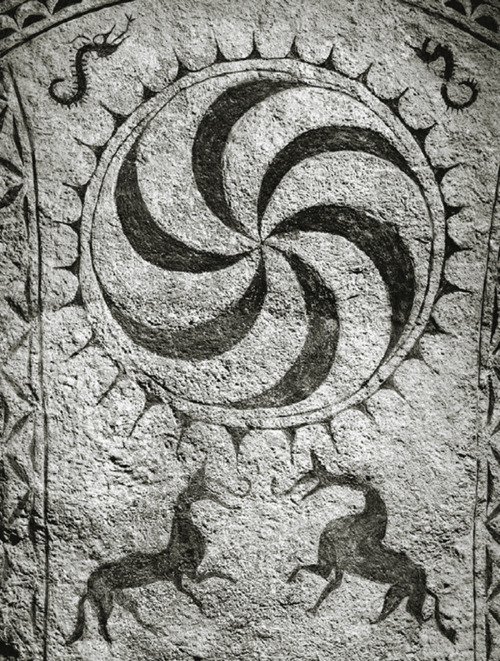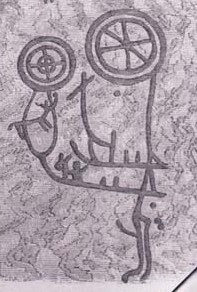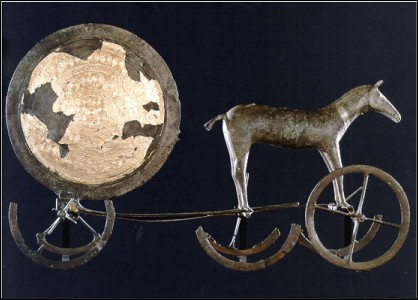The Poetic Edda: A Study Guide
The Speech of the Masked One

[PREVIOUS][MAIN][NEXT]
[HOME]
MS No. 2365 4to [R]
AM 748 I 4to [A]
Normalized Text:
Árvakr ok Alsvíþr,
þeir skulu upp héðan
sval svangir sól draga;
en und þeira bógum
fálu blíð regin,
æsir ísarn kol.
Árvakr ok Alsviðr,
þeir skulu upp héðan
svangir sól draga;
en und þeira bógum
fálu blíð regin,
æsir, ísarnkol.
37. Árvakr ok Alsviðr,
þeir skulu upp héðan
svangir sól draga;
en und þeira bógum
fálu blíð regin,
æsir, ísarnkol.
in Icelandic Poetry
“The Song of Grimnir”
in Edda Sæmundar Hinns Frôða
“The Lay of Grimnir”
XXXVII.
Yok'd to the chariot of the Sun,
Each day thro' heav'n two coursers[1]
run:
Then Gods beneath their helmets love
In iron canopy to rove.
[1]
. "Two Coursers," --- Arvacer and Alsuither, the horses of the Sun.
37. Arvakr and Alsvid,
theirs ´tis up hence
fasting the sun to draw:
under their shoulder
the gentle powers, the Æsir,
have concealed an iron-coolness.
in Corpus Poeticum Boreale
“The Sayings of the Hooded One”
in Edda Saemundar
“The Sayings of Grimnir”
draw the Sun hence, and under their
shoulders the blissful powers,
the Anses, hid the cooling of iron.
37. Early-woke, All-fleet, hence must these horses
wearily draw up the sun,
but under their withers the gods, gracious Powers,
an iron-coolness have hid.
in The Poetic Edda
“Grimnismol: The Ballad of Grimnir”
in The Poetic Edda
“The Lay of Grimnir”
37. Arvak and Alsvith up shall drag
Weary the weight of the sun;
But an iron cool have the kindly
gods
Of yore set under their yokes.
38. Árvakr and Alsvith, they up shall draw
the sun's wain wearily;
but under their bellies the blessed gods
have hidden the "icy irons."
in The Elder Edda
“The Lay of Grimnir”
in The Poetic Edda
“Grimnir’s Sayings”
Up shall rise All-Swift and
Early-Awake,
Hungry, to haul the Sun:
Under their shoulders shall the gods
Carry cold iron.
37. Arvak and Alsvid, they
must pull wearily
the sun from here;
and under their Saddle-bows the cheerful gods,
the Æsir, have hidden iron bellows.
The Elder Edda: A Book of Viking Lore
'The Lay of Grimnir"
in The Poetic Edda, Vol. III: Mythological Poems
“The Lay of Grimnir”
37. ‘Early-waker, All-swift: from here they have to drag
wearily on Sun;
but under their saddle-bows the Æsir have concealed,
kind powers, cooling irons.
37. Early Waker and All Strong
—slim steeds—up from here
have to haul the sun;
but under their withers the blithe powers
implanted
eternal [currents of] iron-cold air.

Engraved stone found in Havor, Gotland (Historiska Museet Stockholm)
COMMENTARY
The expression blíð regin, "blithe powers" also occurs in Grímnismál stanzas 6 , 47, and Lokasenna 32.
The team Arvakr and Alsvinn are mentioned together again in Sigrdrífumál 15. Speaking of runes, it says:
|
Á skildi kvað ristnar, |
On the shield they should be cut, that stands before the bright god, on Early-waker's ears and on All-swift's hoof, on the wheel that turns under Hrungnir's car, on Sleipnir's teeth, and on the sledge's straps. |
The horses which draw the sun are also named in Gylfaginning 11 and Skáldskaparmál 58. The information in Gylfaginning 11 appears to originate in this stanza:
|
Þá mælti Gangleri: "Hversu stýrir hann gang sólar eða
tungls?" |
Then said Gangleri: "How does he govern the course of the sun or of the moon?" Hárr answered: "A certain man was named Mundilfari, who had two children; they were so fair and comely that he called his son Moon, and his daughter Sun, and wedded her to the man called Glenr. But the gods were incensed at that insolence, and took the brother and sister, and set them up in the heavens; they caused Sun to drive those horses that drew the chariot of the sun, which the gods had fashioned, for the world's illumination, from that glowing stuff which flew out of Múspellheim. Those horses are called thus: Early-Wake and All-Strong; and under the shoulders of the horses the gods set two wind-bags to cool them, but in some records that is called 'iron-coolness.' |
Alsviðr is mentioned again in Hrafnagaldur Óðinns, although the reference is obscure:
|
Dugir með dvergum |
4. The dwarves' powers dwindle, the worlds sink down towards Ginnung's abyss; Often Alsviður fells from above often he gathers the fallen again. |
|
Stendur æva |
5/1-4: Earth and Sun cannot stand firm malignant winds do not cease; |
In stanza 4, which may well be corrupt, it is unclear what it is that Alsviðr "fells from above" and "gathers up again".
| The Solar Steeds: Here Comes the Sun |
...Etása ('Swift') is often mentioned as the steed who draws the sun or Sun's wheel. Dawn is said to bring with her the eye of the gods and to bring it with her on a fair white horse (Rigveda 7.77.3).
"Among the many rock carvings from Scandinavia, dating from between 1500 and 400 BCE, are a number depicting a horse or a pair of horses pulling a wheel or disc. One from Kalleby in Bohuslän, Sweden, shows a horse pulling a large four-spoked wheel and hovering over a longship [Glob (1974), 103, 151 fig. 61; M. Green (1991), 78, 70, fig 61]. Another from Balken in the same region shows a horse with a band running back from its head to a disc that flies above its back. Further designs of a horse pulling the sun, her represented by concentric and/or radiate circles, appear on several bronze razors from different sites in Denmark [F. Kaul in Meller (2004) 57, 61 (fig. centre right; first millennium BCE)]. In all of the above except the Kalleby carving, the horse is facing to the right, in other words pulling the sun in the direction in which it is seen to cross the sky.
 |
 |
 |
"The most spectacular of Scandinavian representations is the famous Trundholm sun-horse, discovered in 1902 in a bog in north-west Zealand. This bronze model about 25 cm long, drawing behind it a bronze disc, taller than itself, 26 cm. in diameter. The whole group measures about 60 cm in length. The disc has a bright side, covered with gold leaf, and a dull side; the bright side is displayed when the group is viewed with the horse facing to the right. The set was mounted on three pairs of wheel, two for the horse and one for the sun-disc, each wheel having four slender spokes and actually able to turn. The remarkable artefact, now in the National Museum in Copenhagen, is dated to about the fourteenth century BCE. It is not unique: fragments of a similar assembly, but with two horses, had been found a few years earlier near Hälsingborg on the other side of the sound. Sun-discs comparable to the one in the Trundholm group have been found in Ireland, the Isle of Man, and near Bath."
"...Tacitus knew the rumour of a Baltic region where the sun did not sink far enough beneath the semi-frozen sea to allow the stars to shine (Germania 45, 1). When it rose, the sound was audible, so people believed, and the outlines of horses (equorum: v.l. deorum, eorum) and the rays emanating from the gods' head could be discerned."
—M.L. West, Indo-European Poetry and Myth, 2007, pp. 203-206.
[PREVIOUS][MAIN][NEXT]
[HOME]